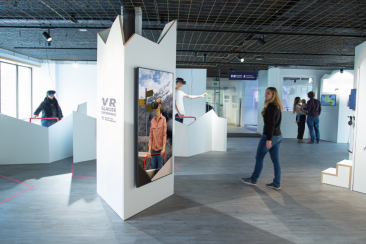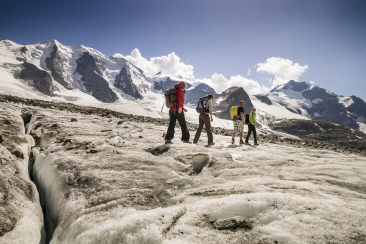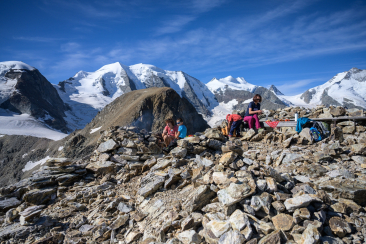Diavolezza Glacier Experience.
Why are you Crying, Glacier?
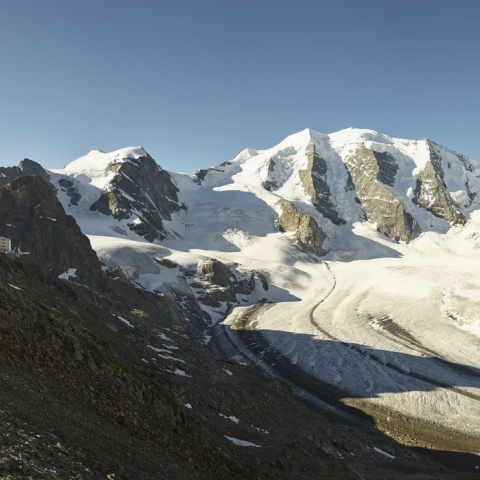
«Why are you crying, glacier? Is it the sadness of parting that overwhelms you?» are the opening words of a poem by Fritz Gillinger from 2014. Guests in the Engadine often catch their first glimpse of the Morteratsch Glacier from the Montebello Curve. Here, where the road and railway line cross between Pontresina and Berninahospiz, the Bernina Range with its snow-white peaks is an impressive sight to behold on the right-hand side. Below this are the two ice streams Pers and Morteratsch, which flow round the Isla Persa: this 16 square-metre ice sculpture in the Upper Engadine makes for a proud and awe-inspiring sight. No hint of sadness whatsoever.
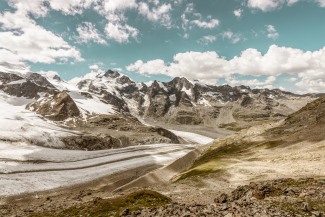
«Mort Aratsch!»
For sure-footed visitors, the Diavolezza marks the starting point for exploring this eternal ice; 1.5 billion tonnes that are constantly moving. Only those who are familiar with Morteratsch know where new crevasses or moulins have formed and where glacier caves can be accessed. Boulders or whole tree trunks that the eternal ice has deposited line the path and tell stories from previous centuries. Only unlucky Aratsch still remains missing to this day.
According to legend, the former herdsman – after spending years away – returned to the valley and found his beloved Annetta on her deathbed. In helpless desperation, poor Aratsch rode up to the glacier on his horse, where all traces of him were lost forever. His memory lives on: Annetta’s spirit was unable to rest and could be heard wailing on quiet nights: «Mort Aratsch, mort Aratsch!», thus giving the glacier its name.
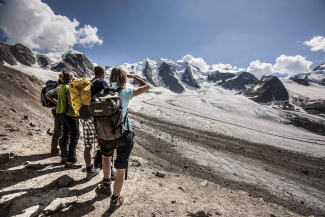
The Nobility is Impressed
The Leipzig-based artist Wilhelm Georgy also experienced restless days when he planned drawing studies of the «mighty ice spikes and peaks at the far back of the Morteratsch Glacier» in 1854. Equipped with blankets and cooking utensils, they stayed under blocks of stone, even though it was late autumn, and heard «the dull, gunfire-like crashing of the bursting and falling ice masses». «It seemed as though the terrible glacier was bursting with anger that a human had dared to listen in and set its secret beauties down onto paper,» writes Georgy in his account «Hotel Granitblock».
At that time – around the end of the Little Ice Age – the glacier moved to the current location of the railway station. By as early as 1905, when the Kessler family built their first hotel there, and when the Bernina railway, including Morteratsch station, was created in 1910, the ice stream had already retreated a few hundred metres. The easy accessibility of the glacier was a sensation, which, in the belle époque of Engadine tourism, was something even the German Emperor Wilhelm did not want to miss out on. Photographs show him on a glacier walk with a retinue of men in fine suits and ladies with wide hats and elegant little handbags.
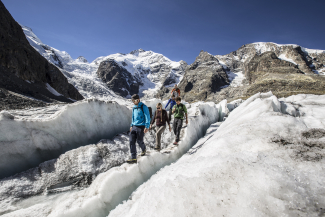
High-Tech at the Glacier
Today, a gravel path measuring around three kilometres needs to first be followed on foot or bike to get close to the glacier. Year after year, the Morteratsch Glacier retreats by around 40 metres, a development that local glaciologist Felix Keller is unwilling to simply accept. The glacier care project MortAlive (see page 14) that he has set up aims to develop a groundbreaking snowmaking technology that can delay, although not prevent, the melting of the glacier. Not only in the Engadine or in the Alps, but rather in the Andes or Himalayas, where around 200 million people’s lives are threatened by the absence of meltwater.
Meanwhile, things are changing in the exposed foreland of the Morteratsch Glacier. What are known as pioneer plants such as Linaria alpina or Dryas are clinging to the loose scree of the grey moraine, alpine roses are beginning to flower and populations of Swiss pine and larch are spreading with meadows and green alder. A new landscape is being created. And so Gillinger’s poem asks the questions: «Why are you crying, glacier?... Because you are constantly on the move? Away from the cold place that feeds you. Unwaveringly downward to where you transform? Or are they glacial tears of joy for the new life that you are creating?»
Did you know...?
The Morteratsch Glacier, together with the Pers Glacier, covers an area of 16 km2. It is thus one of the largest glaciers in the Alps. It has been melting at a rate of around 40 metres per year since 1999. The project MortAlive led by glaciologist Felix Keller intends to counteract this deglaciation by recycling meltwater. The idea is to cover the glacier in snow with snow ropes so that the ice underneath can be preserved. Initial field tests at the Diavolezza valley station have been successful.


